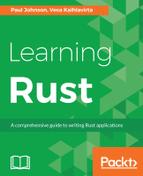A loop condition can also be more complex, using multiple conditions and variables. For example, the for loop can be tracked using enumerate. This will keep track of how many times the loop has executed, as shown here:
for(i, j) in (10..20).enumerate()
{
println!("loop has executed {} times. j = {}", i, j);
}
The following is the output:

Say we have an array that we need to iterate over to obtain the values. Here, the enumerate method can be used to obtain the value of the array members. The value returned in the condition will be a reference, so a code such as the one shown in the following example will fail to execute (line is a & reference whereas an i32 is expected):
// 04/enumerate/src/main.rs
fn main() { let my_array: [i32; 7] = [1i32,3,5,7,9,11,13]; let mut value = 0i32; for(_, line) in my_array.iter().enumerate() { value += line; } println!("{}", value); }
This can be simply converted back from the reference value, as follows:
for(_, line) in my_array.iter().enumerate()
{
value += *line;
}
The iter().enumerate() method can equally be used with the Vec type (or any other type that implements the iterator trait), as shown in the following code:
// 04/arrayloop/src/main.rs
fn main() { let my_array = vec![1i32,3,5,7,9,11,13]; let mut value = 0i32; for(_,line) in my_array.iter().enumerate() { value += *line; } println!("{}", value); }
In both cases, the value given at the end will be 49, as shown in the following screenshot:

